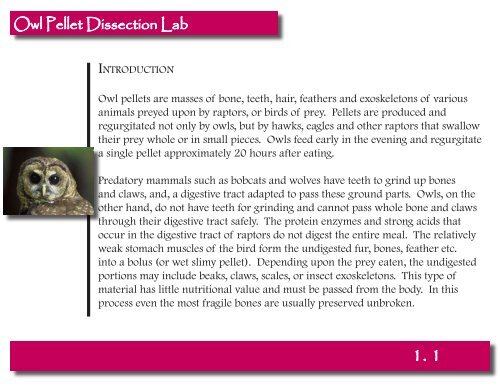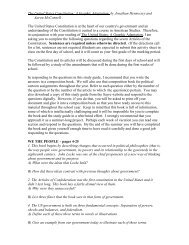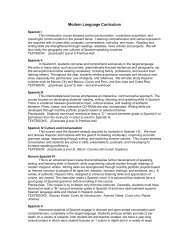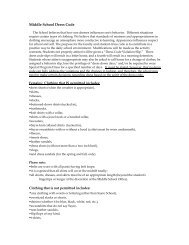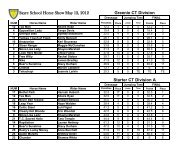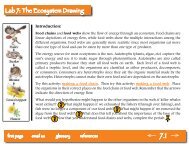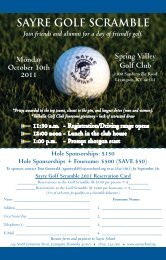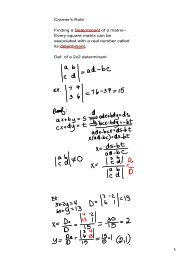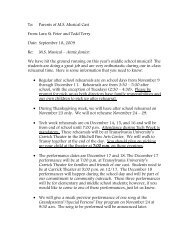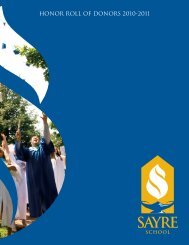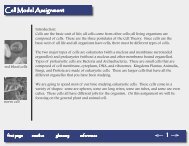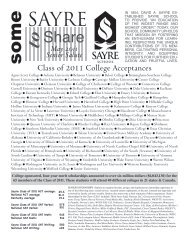Owl Pellet Dissection Lab
Owl Pellet Dissection Lab
Owl Pellet Dissection Lab
You also want an ePaper? Increase the reach of your titles
YUMPU automatically turns print PDFs into web optimized ePapers that Google loves.
<strong>Owl</strong> <strong>Pellet</strong> <strong>Dissection</strong> <strong>Lab</strong><br />
Introduction<br />
<strong>Owl</strong> pellets are masses of bone, teeth, hair, feathers and exoskeletons of various<br />
animals preyed upon by raptors, or birds of prey. <strong>Pellet</strong>s are produced and<br />
regurgitated not only by owls, but by hawks, eagles and other raptors that swallow<br />
their prey whole or in small pieces. <strong>Owl</strong>s feed early in the evening and regurgitate<br />
a single pellet approximately 20 hours after eating.<br />
Predatory mammals such as bobcats and wolves have teeth to grind up bones<br />
and claws, and, a digestive tract adapted to pass these ground parts. <strong>Owl</strong>s, on the<br />
other hand, do not have teeth for grinding and cannot pass whole bone and claws<br />
through their digestive tract safely. The protein enzymes and strong acids that<br />
occur in the digestive tract of raptors do not digest the entire meal. The relatively<br />
weak stomach muscles of the bird form the undigested fur, bones, feather etc.<br />
into a bolus (or wet slimy pellet). Depending upon the prey eaten, the undigested<br />
portions may include beaks, claws, scales, or insect exoskeletons. This type of<br />
material has little nutritional value and must be passed from the body. In this<br />
process even the most fragile bones are usually preserved unbroken.<br />
1.
<strong>Owl</strong> <strong>Pellet</strong> <strong>Dissection</strong> <strong>Lab</strong><br />
Scientists take advantage of this adaptation by collecting these pellets and<br />
examining their contents. Since owls are not very selective feeders, these pellets<br />
can be used to estimate the diversity of available prey. The contents are also a<br />
direct indicator of what an owl has fed on; information that is crucial for species<br />
management and protection.<br />
The owl pellets that you will be examining in this lab have been<br />
collected and fumigated from common barn owls (Tyto alba). <strong>Owl</strong><br />
pellets themselves are ecosystems, providing food and shelter for<br />
communities that may include clothes moths, carpet beetles and fungi.<br />
Clothes moth larvae are frequently abundant in pellets, feeding on fur<br />
and feathers. The black spheres about the size of periods (.) that are<br />
found in the pellets are the droppings of the caterpillars. The larvae<br />
metamorphose near the surface of a pellet in cocoons made of fur.<br />
1.
<strong>Owl</strong> <strong>Pellet</strong> <strong>Dissection</strong> <strong>Lab</strong><br />
Materials:<br />
• owl pellet (wrapped in aluminum foil)<br />
• brown glass specimen jar (cap optional)<br />
• dishwashing detergent or hand soap<br />
• cheese cloth<br />
• forceps<br />
• 2 dissecting mounts<br />
• dissecting probe<br />
• dissecting pan/tray (located at station)<br />
• several sheets of white paper (recycled)<br />
• 2 specimen dishes and/or watch glasses/petri dishes<br />
• metric balance<br />
• ruler<br />
• stereoscopic dissecting microscope<br />
• magnifying glass<br />
• water<br />
• paper towel<br />
• desiccating oven (high temp.)<br />
• latex gloves (pair for each partner)<br />
1.
<strong>Owl</strong> <strong>Pellet</strong> <strong>Dissection</strong> <strong>Lab</strong><br />
Procedure:<br />
1. Unwrap and examine the outside of the owl pellet. Put all data and observations<br />
on the Data, Observations, & Analysis page. Describe the external<br />
features. Measure and record its length and width in centimeters. Measure<br />
and record the owl pellet mass in grams.<br />
2. To investigate the interior of the pellet you must soften it by soaking it<br />
in water. Fill the specimen jar 3/4 full with tap water. Add a drop or two<br />
of dishwashing liquid or hand soap and the pellet to the jar. Close the<br />
jar with a cap or cover with your gloved hand and shake gently for about<br />
30 seconds. Let the jar stand for five minutes and shake again for 30<br />
seconds.<br />
3. When the pellet has fallen apart, have your partner hold the cheese cloth,<br />
and slowly pour the contents of the jar over the cheese cloth. Be careful<br />
not to allow any animal fragments, bone, or fur wash into the sink.<br />
1.
<strong>Owl</strong> <strong>Pellet</strong> <strong>Dissection</strong> <strong>Lab</strong><br />
4. Place the cheese cloth on a piece of white paper. Pick bones, teeth, insect<br />
parts, and any other prey evidence out of the fur and place all prey evidence<br />
(except skulls) in a specimen dish or watch glass. Place the skulls on a second<br />
sheet of paper. Use probes, dissecting mounts, or forceps, as necessary, but<br />
proceed carefully to avoid crushing any small bones. Separate the fur and<br />
other soft matter as you search for bones by placing them in a separate<br />
specimen dish or watch glass.<br />
5. <strong>Lab</strong>el the skulls by number, and use this dichotomous key to<br />
identify them. Record the species of each skull on your answer sheet.<br />
6. Try to match other bones to each skull. Use the preserved specimens<br />
and the diagrams of animal bone structures provided to identify each<br />
bone and record its name under its matching skull on your answer<br />
sheet.<br />
7. Use the links provided with the dichotomous key to find the likely habitat and<br />
diet of each species found in the pellet. Record the information on your answer<br />
sheet.<br />
1.
<strong>Owl</strong> <strong>Pellet</strong> <strong>Dissection</strong> <strong>Lab</strong><br />
8. Talk with other groups and find the types and number of species found in all of<br />
the pellets. Record this in Table 2.<br />
9. Once all bones have been identified, collect your bones in the specimen dish.<br />
Carefully dry as many as you can with one or two pieces of paper towel. Add<br />
the other organic matter (i.e. fur and small miscellaneous pieces). Then, make<br />
a small mark on your specimen dish to be able to identify it, and place your<br />
entire specimen dish in a high temperature oven for drying. Check the organic<br />
matter after 24 hours to record the biomass.<br />
10. Complete the Answer Sheet and make sure both team members<br />
have a copy.<br />
11. Complete the Homework for this lab.<br />
1.
<strong>Owl</strong> <strong>Pellet</strong> <strong>Dissection</strong> <strong>Lab</strong><br />
References<br />
“Alcorn/AP Environmental Science <strong>Owl</strong> <strong>Pellet</strong> <strong>Dissection</strong>.” Dr. Decino’s webpage.<br />
Carlsbad High School. 27 Oct. 2008 .<br />
Gautschi, D. Tobias. “<strong>Owl</strong> <strong>Pellet</strong> <strong>Lab</strong>.” Mr. Gautschi’s Home Page. El Dorado High<br />
School. 27 Oct. 2008. .<br />
Radcliffe, G. “HUMAN BODY <strong>Lab</strong> 3: <strong>Owl</strong> <strong>Pellet</strong> <strong>Dissection</strong>.” Human Body Unit.<br />
Centreville Middle School. 27 Oct. 2008 .<br />
1.
<strong>Owl</strong> <strong>Pellet</strong> <strong>Dissection</strong> <strong>Lab</strong><br />
Images<br />
Image:Shituan.jpg (<strong>Pellet</strong>s from a long eared owl)<br />
This file is licensed under the creative commons attribution sharealike 2.5 license. in short: you are free to<br />
share and make derivative works of the file under the conditions that you appropriately attribute it, and that<br />
you distribute it only under a license identical to this one. official license<br />
Barn owl images (both adult and chicks)<br />
florinorfolk. “Magic <strong>Owl</strong>s.” weblog post. photorama . 29 may 2008. flickr. 27 Oct. 2008. .<br />
Image: close-up of mole.jpg<br />
Permission is granted to copy, distribute and/or modify this document under the terms of the gnu free<br />
documentation license, version 1.2 or any later version published by the free software foundation; with no<br />
invariant sections, no front-cover texts, and no back-cover texts.<br />
Image: northern spotted owl.usfws-thumb.jpg<br />
This image or recording is the work of an u.s. fish and wildlife service employee, taken or made during<br />
the course of an employee’s official duties. as a work of the U.S. federal government, the image is in the<br />
public domain. for more information, see the fish and wildlife service copyright policy.<br />
1.


